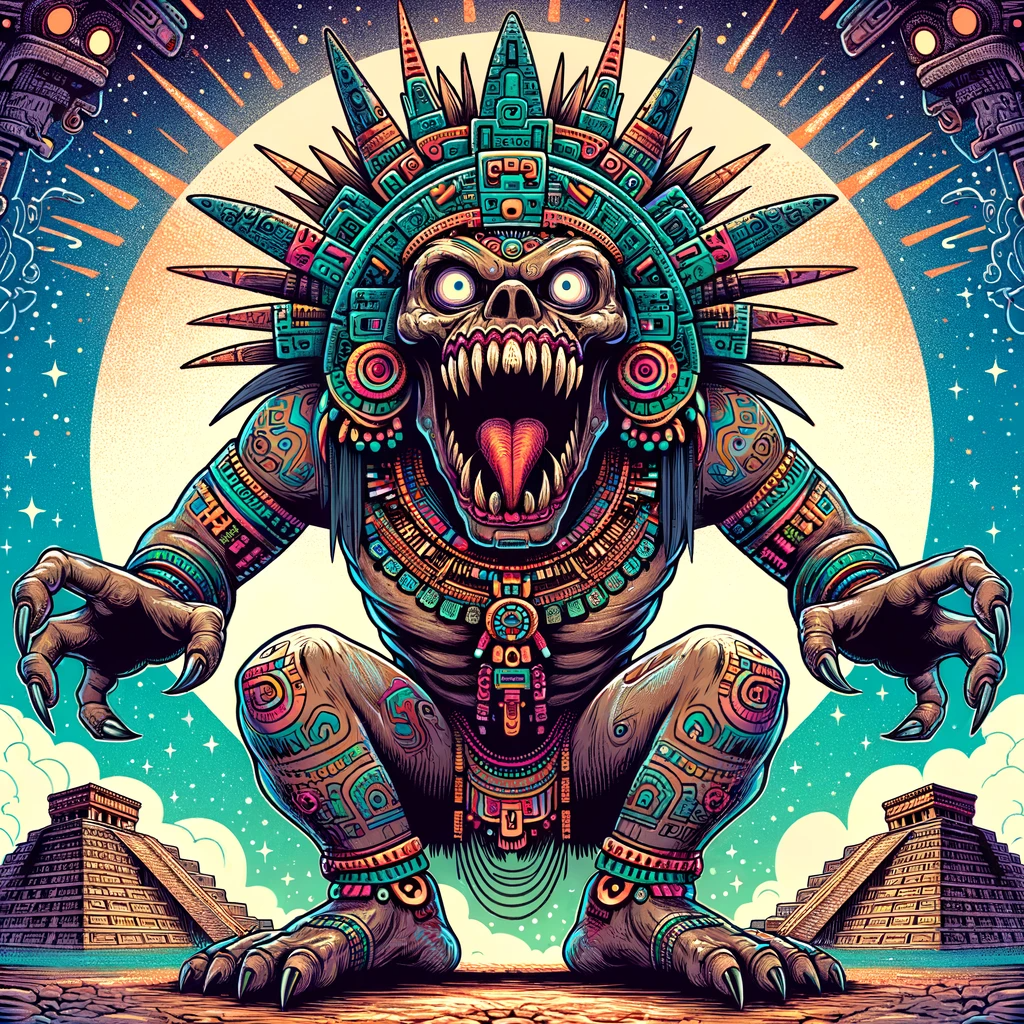
In the pantheon of Aztec mythology, Tlaltecuhtli holds a unique and significant place as the deity of the earth. This article delves into the history, symbolism, and cultural significance of Tlaltecuhtli, providing insights into the rich tapestry of Aztec beliefs and their view of the cosmos.
Origins and Mythology
Tlaltecuhtli, whose name translates to "Lord of the Earth," is a deity in Aztec mythology associated with the earth and its fertility. This god was often depicted as a fearsome creature with a gaping mouth and sharp claws, reflecting the Aztecs' belief in the earth's power and ferocity.
According to Aztec creation myths, Tlaltecuhtli played a crucial role in the formation of the world. The god was initially a monstrous sea creature that roamed the primordial waters. The gods Quetzalcoatl and Tezcatlipoca, in their quest to create land, transformed themselves into serpents and tore Tlaltecuhtli apart. From the dismembered body, the earth was formed—her head and hair became the mountains and valleys, her blood the rivers, and her skin the vast landscapes.
Depictions and Symbolism
Tlaltecuhtli is often portrayed as a creature with a blend of human and animal features, lying on its back or sometimes depicted with a gaping mouth, symbolizing the earth’s hunger for blood and sacrifice. This imagery was not only a representation of the deity but also a reflection of the Aztec belief in the need for continuous sacrifices to appease the gods and maintain cosmic order.
In Aztec art, Tlaltecuhtli is frequently shown in a squatting position, often with a river or stream of water flowing from her mouth, symbolizing fertility and the life-giving aspects of the earth. The deity is sometimes portrayed as androgynous or as having dual gender, embodying both the masculine and feminine aspects of creation and destruction.
Cultural Significance
For the Aztecs, Tlaltecuhtli was more than just a mythological figure; the deity represented the very essence of their world. The belief in Tlaltecuhtli influenced various aspects of Aztec culture, from agriculture to architecture. Temples and ceremonial centers were often built with the deity in mind, aiming to align with the sacred energies of the earth.
Tlaltecuhtli's demand for blood and human sacrifice underlined the Aztec view of the reciprocal relationship between gods and humans. They believed that human blood was a powerful source of nourishment for the gods, and in return, the gods would ensure the fertility of the land and the well-being of the people.
Conclusion
Tlaltecuhtli stands as a testament to the complexity and depth of Aztec mythology and religious beliefs. This deity's dual nature of creation and destruction, fertility and hunger, encapsulates the Aztecs' understanding of the world as a place of constant balance and cycle. Today, Tlaltecuhtli continues to fascinate scholars and enthusiasts alike, offering a window into the ancient worldview of one of history's most intriguing civilizations.
Origins and Mythology
Tlaltecuhtli, whose name translates to "Lord of the Earth," is a deity in Aztec mythology associated with the earth and its fertility. This god was often depicted as a fearsome creature with a gaping mouth and sharp claws, reflecting the Aztecs' belief in the earth's power and ferocity.
According to Aztec creation myths, Tlaltecuhtli played a crucial role in the formation of the world. The god was initially a monstrous sea creature that roamed the primordial waters. The gods Quetzalcoatl and Tezcatlipoca, in their quest to create land, transformed themselves into serpents and tore Tlaltecuhtli apart. From the dismembered body, the earth was formed—her head and hair became the mountains and valleys, her blood the rivers, and her skin the vast landscapes.
Depictions and Symbolism
Tlaltecuhtli is often portrayed as a creature with a blend of human and animal features, lying on its back or sometimes depicted with a gaping mouth, symbolizing the earth’s hunger for blood and sacrifice. This imagery was not only a representation of the deity but also a reflection of the Aztec belief in the need for continuous sacrifices to appease the gods and maintain cosmic order.
In Aztec art, Tlaltecuhtli is frequently shown in a squatting position, often with a river or stream of water flowing from her mouth, symbolizing fertility and the life-giving aspects of the earth. The deity is sometimes portrayed as androgynous or as having dual gender, embodying both the masculine and feminine aspects of creation and destruction.
Cultural Significance
For the Aztecs, Tlaltecuhtli was more than just a mythological figure; the deity represented the very essence of their world. The belief in Tlaltecuhtli influenced various aspects of Aztec culture, from agriculture to architecture. Temples and ceremonial centers were often built with the deity in mind, aiming to align with the sacred energies of the earth.
Tlaltecuhtli's demand for blood and human sacrifice underlined the Aztec view of the reciprocal relationship between gods and humans. They believed that human blood was a powerful source of nourishment for the gods, and in return, the gods would ensure the fertility of the land and the well-being of the people.
Conclusion
Tlaltecuhtli stands as a testament to the complexity and depth of Aztec mythology and religious beliefs. This deity's dual nature of creation and destruction, fertility and hunger, encapsulates the Aztecs' understanding of the world as a place of constant balance and cycle. Today, Tlaltecuhtli continues to fascinate scholars and enthusiasts alike, offering a window into the ancient worldview of one of history's most intriguing civilizations.